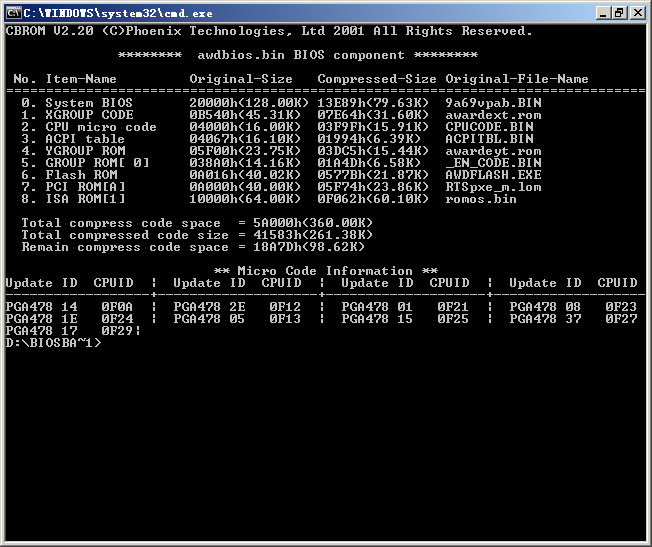
Cbrom Exe Bios
The New version of Award CBROM.EXE can be use to extract VGA, Net boot rom.etc. The command of the extraction is just like releasing BIOS.
Simply just replace the word 'release' to 'extract'. For example, to extract VGA and net BIOS, please type: cbrom 6144V23.bin /vga extract cbrom 6144V23.bin /others 1800:0 extract Note that you can use the '/d' command to check the BIOS configureation and free space of the BIOS.
Jul 18, 2018 - Preliminary Notes: • Before you start with the BIOS modding procedure, it is strongle recommended to read carefully the separately published.

This version of CBROM is helpful, so we do not need to use 'debug' to extract VGA for Award BIOS. Unfortunitely, AMI BIOS does not. Download File Released Date Download Site Cbrom.exe 2001-03-20 • • Thank you! I cannot download file in this page: We will send you the file if you fill your email below.
 I'm almost 40 but that won't stop me from changing my life.it sure won't stop them from trying to work me to death which is the alternative. I hate it and I am going back to school for something else. Think about how you really want to live.good luck. I never know if I work days or nights.
I'm almost 40 but that won't stop me from changing my life.it sure won't stop them from trying to work me to death which is the alternative. I hate it and I am going back to school for something else. Think about how you really want to live.good luck. I never know if I work days or nights.
• • • • Reading Time: ~ 6 min. By Marco Giuliani In the past few weeks a Chinese security company called blogged about a new BIOS rootkit hitting Chinese computers. Indijskaya scenka na novij god dlya korporativa. This turned to be a very interesting discovery as it appears to be the first real malware targeting system BIOS since a well-known proof of concept called IceLord in 2007. The malware is called Mebromi and contains a bit of everything: a BIOS rootkit specifically targeting Award BIOS, a MBR rootkit, a kernel mode rootkit, a PE file infector and a Trojan downloader. At this time, Mebromi is not designed to infect 64-bit operating system and it is not able to infect the system if run with limited privileges. The infection starts with a small encrypted dropper that contains five crypted resource files: hook.rom, flash.dll, cbrom.exe, my.sys, bios.sys. The goal of these files will be presented later in this analysis.
The infection is clearly focused on Chinese users, because the dropper is carefully checking if the system it’s going to infect is protected by Chinese security software Rising Antivirus and Jiangmin KV Antivirus. To gain access to the BIOS, the infection first needs to get loaded in kernel mode so that it can handle with physical memory instead of virtual memory. Many of you may recall the old CIH/Chernobyl infection, the infamous virus discovered in 1998 that was able to flash the motherboard BIOS, erasing it. Even CIH needed to gain kernel mode access to reach the BIOS, though at the time the virus was exploiting a privilege escalation bug in Windows 9x operating system which allowed it to overwrite the Interrupt Descriptor Table with its own payload from user mode, then triggering the overwritten interrupt handler and its malicious code is executed in kernel mode.
Mebromi does not use such kind of privilege escalation trick anymore, it just needs to load its own kernel mode driver which will handle the BIOS infection. To do so, it uses two methods: it could either extract and load the flash.dll library which will load the bios.sys driver, or it stops the beep.sys service key, overwriting the beep.sys driver with its own bios.sys code, restart the service key and restore the original beep.sys code. The bios.sys driver is the code which handle the BIOS infection. To read the BIOS code, it needs to map the physical memory located at physical memory address 0xF0000, this is where the BIOS ROM usually resides.